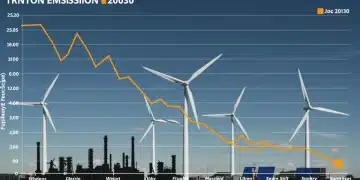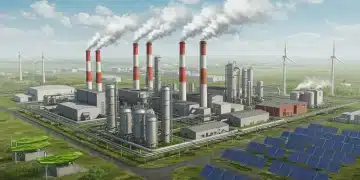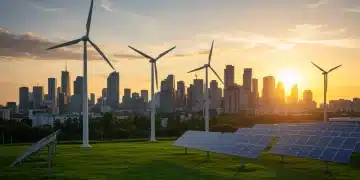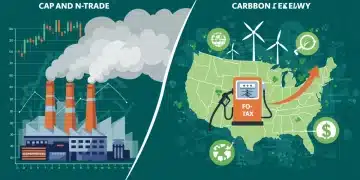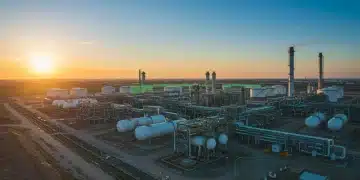US 2030 Emission Targets: Crucial Deadline Approaching
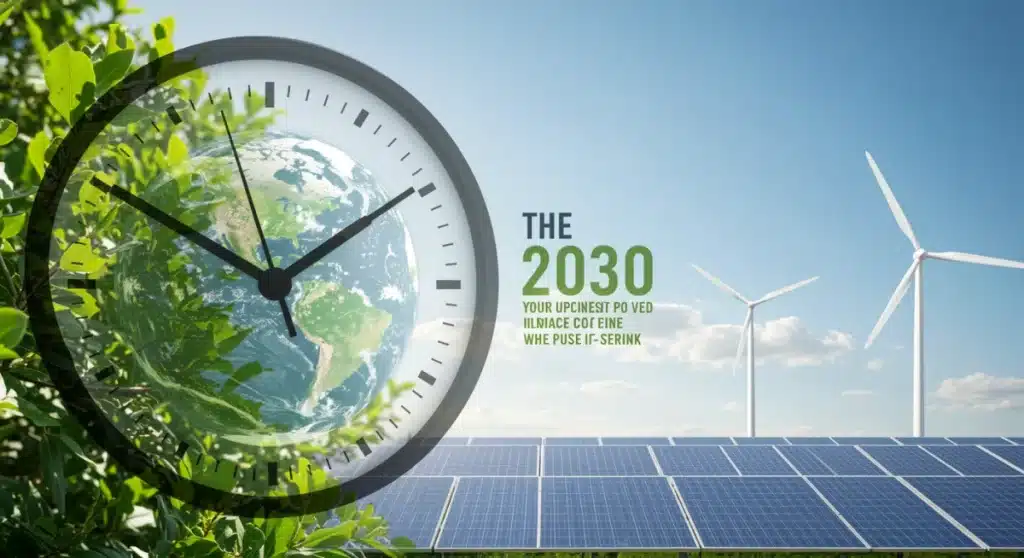
As the clock ticks, the US 2030 emission targets loom large, representing a pivotal moment in the nation’s commitment to combating climate change. The urgency of this deadline cannot be overstated, directly impacting global environmental efforts and the future of sustainable development.
The Impending Deadline for US Climate Action
The United States is fast approaching a critical juncture concerning its climate commitments. The 2030 deadline for significant emission reductions, established under the Paris Agreement, is now less than six years away. This target mandates a 50-52% reduction from 2005 levels, a goal that requires unprecedented action across all sectors of the economy.
Recent reports from environmental agencies and independent watchdogs indicate that while progress has been made, the pace of reduction needs to accelerate dramatically. The current administration has emphasized a whole-of-government approach, but the implementation and scaling of policies are key to closing the remaining gap.
Why 2030 Matters Most
The year 2030 is not an arbitrary date; it’s a scientific benchmark. The Intergovernmental Panel on Climate Change (IPCC) has repeatedly highlighted the need for drastic global emission cuts by this decade to keep global warming below 1.5°C, thereby avoiding the most catastrophic impacts of climate change. The US, as a major historical emitter, plays a crucial role in achieving this global objective.
- Scientific Imperative: Aligns with IPCC recommendations to avert severe climate consequences.
- Global Leadership: Demonstrates US commitment to international climate agreements and encourages other nations.
- Economic Opportunity: Drives innovation and investment in green technologies and industries.
- Public Health Benefits: Reduces air pollution, leading to improved health outcomes for communities.
Current Status of US Emission Reductions
As of late 2023 and early 2024, the United States has made measurable strides in decarbonization, primarily driven by shifts in the power sector and advancements in renewable energy technologies. According to the Environmental Protection Agency (EPA), emissions have decreased by approximately 17% from 2005 levels. However, this progress is insufficient to meet the ambitious 2030 target without further, aggressive interventions.
The energy transition continues to be a cornerstone of the strategy, with solar and wind power experiencing significant growth. Yet, challenges persist in sectors like transportation, industry, and agriculture, where emissions reductions have been slower and more difficult to achieve. Policy frameworks such as the Inflation Reduction Act (IRA) are expected to provide substantial impetus, but their full impact is still unfolding.
Key Sectors and Their Contributions
Each sector presents unique opportunities and obstacles in the journey towards the 2030 goals. The power sector has seen the most rapid changes, but others lag.
- Electricity Generation: Transition from coal to natural gas and renewables has been a major driver of reductions. Further investments in grid modernization and energy storage are crucial.
- Transportation: Electrification of vehicles (EVs) is accelerating, supported by federal incentives and infrastructure build-out. However, the sheer volume of internal combustion engine vehicles remains a challenge.
- Industry: Decarbonizing heavy industry requires significant technological breakthroughs and large-scale investment in areas like carbon capture, utilization, and storage (CCUS) and green hydrogen.
- Buildings: Improving energy efficiency in residential and commercial buildings through retrofits and updated building codes offers substantial reduction potential.
Policy Frameworks Driving the Change
The legislative and regulatory landscape in the US is actively shaping the path toward the 2030 emission targets. Landmark legislation, coupled with executive actions, forms the backbone of the national climate strategy. The effectiveness of these policies will determine the nation’s ability to meet its commitments.
The Inflation Reduction Act (IRA), signed into law in August 2022, represents the largest climate investment in US history. It provides billions of dollars in tax credits, rebates, and incentives for renewable energy, energy efficiency, electric vehicles, and other clean technologies. This act is projected to significantly lower emissions, though estimates vary on its exact contribution to the 2030 goal.
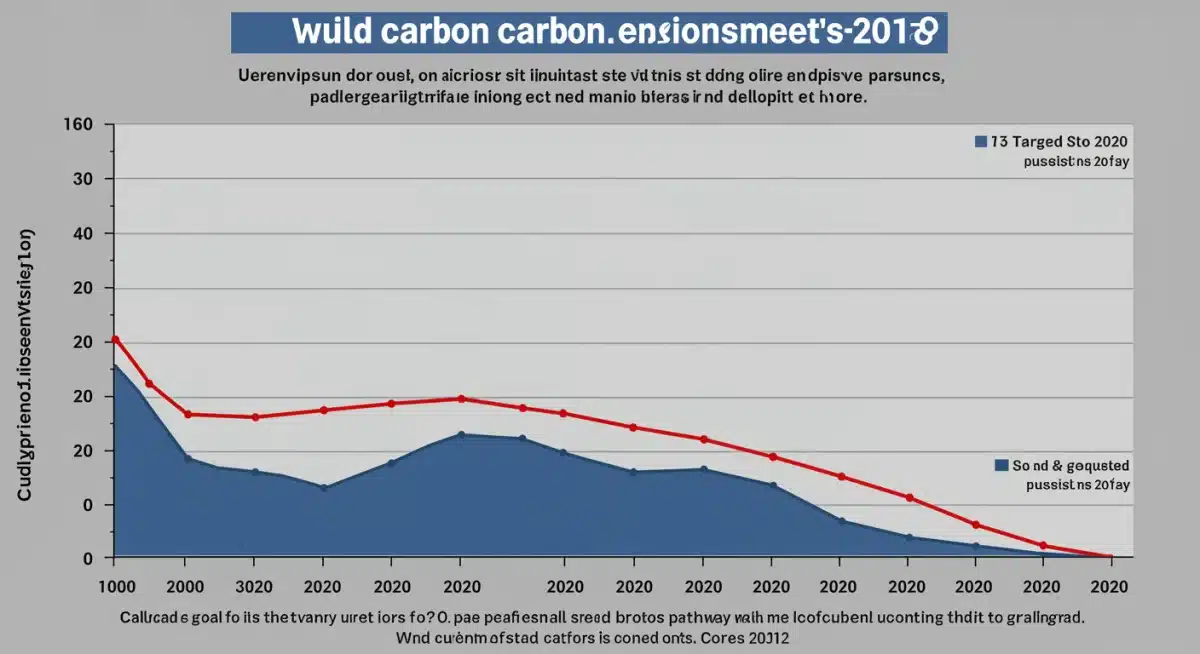
Impact of the Inflation Reduction Act
The IRA’s provisions are designed to accelerate the deployment of clean energy and reduce consumer costs, thereby overcoming some of the economic barriers to decarbonization. Its long-term tax credits provide certainty for businesses and investors, fostering a more robust clean energy economy.
- Renewable Energy Tax Credits: Extends and expands credits for solar, wind, and other clean electricity generation.
- Electric Vehicle Incentives: Offers tax credits for new and used EVs, boosting adoption rates.
- Energy Efficiency Rebates: Provides funding for home energy efficiency improvements and electrification.
- Manufacturing Boost: Incentivizes domestic production of clean energy components, strengthening supply chains.
Beyond the IRA, the Bipartisan Infrastructure Law also allocates substantial funding for projects that support emission reductions, such as public transit, EV charging infrastructure, and grid modernization. Regulatory actions by the EPA, Department of Energy, and other agencies are also critical in setting standards and enforcing environmental protections.
Technological Innovations and Challenges
Achieving the ambitious US 2030 emission targets heavily relies on the rapid development and deployment of innovative technologies. While existing solutions like solar and wind power are scaling up, novel approaches are needed to decarbonize hard-to-abate sectors and enhance overall efficiency.
Breakthroughs in battery storage, advanced nuclear power, green hydrogen production, and carbon capture technologies are essential. These innovations not only offer pathways to lower emissions but also present significant economic opportunities for the US to lead in a global green economy. However, scaling these technologies from pilot projects to commercial viability within the tight timeframe remains a significant challenge.
Emerging Technologies for Decarbonization
Investing in research and development, alongside supportive policies, is crucial for bringing these technologies to fruition. The pace of innovation must match the urgency of the climate crisis.
- Advanced Battery Storage: Essential for grid stability and integrating higher levels of intermittent renewable energy.
- Green Hydrogen: Offers a zero-emission fuel source for heavy industry, transportation, and energy storage.
- Direct Air Capture (DAC): A nascent technology that removes CO2 directly from the atmosphere, addressing legacy emissions.
- Small Modular Reactors (SMRs): Advanced nuclear technology offering a compact, flexible, and zero-emission power source.
Despite the promise, these technologies face hurdles including high costs, infrastructure requirements, and public acceptance. Ensuring equitable access and minimizing environmental impacts from new industrial processes are also critical considerations for their successful integration.
Economic Implications and Opportunities
Meeting the US 2030 emission targets carries profound economic implications, presenting both significant costs and substantial opportunities. The transition to a low-carbon economy requires massive investment in new infrastructure, clean technologies, and workforce development. However, the economic benefits of this transition are projected to outweigh the costs in the long run.
New industries are emerging, creating millions of jobs in sectors like renewable energy manufacturing, electric vehicle production, and energy efficiency services. Furthermore, reducing reliance on fossil fuels can enhance energy security and insulate the economy from volatile global energy prices. The cost of inaction, including the economic damages from extreme weather events and health impacts of pollution, far surpasses the investment needed for climate action.
Green Economy Growth
The shift towards a green economy is not just an environmental imperative but an economic one, driving innovation and competitiveness on a global scale.
- Job Creation: Growth in sectors like solar installation, wind turbine manufacturing, and EV production.
- Energy Independence: Reduced reliance on imported fossil fuels stabilizes domestic energy markets.
- Technological Leadership: Positioning the US as a leader in clean energy innovation and exports.
- Reduced Climate Damages: Mitigating the economic costs associated with climate change impacts like floods, droughts, and wildfires.
While some traditional industries may face challenges during this transition, policies are being developed to support affected communities and workers through retraining programs and economic diversification initiatives. The overall aim is a just transition that benefits all segments of society.
Global Context and International Cooperation
The US 2030 emission targets are not isolated domestic goals; they are an integral part of a global effort to address climate change. The United States’ commitment and progress significantly influence international climate diplomacy and encourage other major economies to strengthen their own targets and actions.
Under the Paris Agreement, nations submit Nationally Determined Contributions (NDCs) outlining their climate ambitions. The US target is considered ambitious and crucial for demonstrating leadership. International cooperation, technology transfer, and financial support to developing nations are vital components of a successful global response. The US plays a key role in multilateral forums, advocating for stronger collective action and sharing best practices.
US Role in Global Climate Action
The credibility of US climate diplomacy hinges on its ability to meet its domestic targets, reinforcing its position as a reliable partner in global environmental governance.
- Paris Agreement Leadership: Reaffirming commitment and encouraging other signatories to enhance their NDCs.
- Bilateral Partnerships: Collaborating with countries like China and India on emission reduction strategies and clean energy deployment.
- Climate Finance: Contributing to international funds that support climate adaptation and mitigation in vulnerable nations.
- Technology Sharing: Facilitating the global spread of clean energy technologies and expertise.
The upcoming COP (Conference of the Parties) meetings will continue to be crucial platforms for assessing global progress and ratcheting up ambition. The US performance towards its 2030 goal will undoubtedly be a central point of discussion and influence for future international climate negotiations.
| Key Point | Brief Description |
|---|---|
| 2030 Emission Target | US aims for 50-52% reduction from 2005 levels by 2030, a critical climate goal. |
| Current Progress | Emissions down ~17% from 2005, primarily in power; faster action needed to meet 2030 goal. |
| Key Policy Drivers | Inflation Reduction Act (IRA) and Bipartisan Infrastructure Law are primary legislative tools. |
| Economic Impact | Significant investments create green jobs and enhance energy security, outweighing transition costs. |
Frequently Asked Questions About US Emission Targets
The United States has committed to reducing its greenhouse gas emissions by 50-52% below 2005 levels by the year 2030. This ambitious target is part of its Nationally Determined Contribution (NDC) under the Paris Agreement, aiming to combat climate change effectively.
The 2030 deadline is critical because scientific consensus, notably from the IPCC, indicates that significant global emission reductions by this time are essential to limit global warming to 1.5°C. Failing to meet these targets could lead to more severe and irreversible climate impacts worldwide.
Key policies include the Inflation Reduction Act (IRA), which provides extensive tax credits and incentives for clean energy and electric vehicles, and the Bipartisan Infrastructure Law, funding clean transportation and grid modernization. Executive actions and EPA regulations also play a significant role.
The electricity generation sector has shown the most substantial progress, largely due to the transition from coal to natural gas and the rapid deployment of renewable energy sources like solar and wind power. Other sectors, such as transportation and industry, still face considerable challenges.
Meeting the targets is projected to spur significant economic growth by creating millions of green jobs, fostering innovation in clean technologies, enhancing energy independence, and reducing the substantial costs associated with climate change impacts and health issues from pollution.
What Happens Next
The coming months will be critical for assessing the trajectory of US emission reductions. Watch for ongoing policy implementations from the Inflation Reduction Act, new regulatory proposals from federal agencies, and updates on renewable energy deployment. The effectiveness of these measures will determine if the US can avoid a last-minute scramble and meet its crucial 2030 commitments, shaping both domestic environmental health and global climate action.
